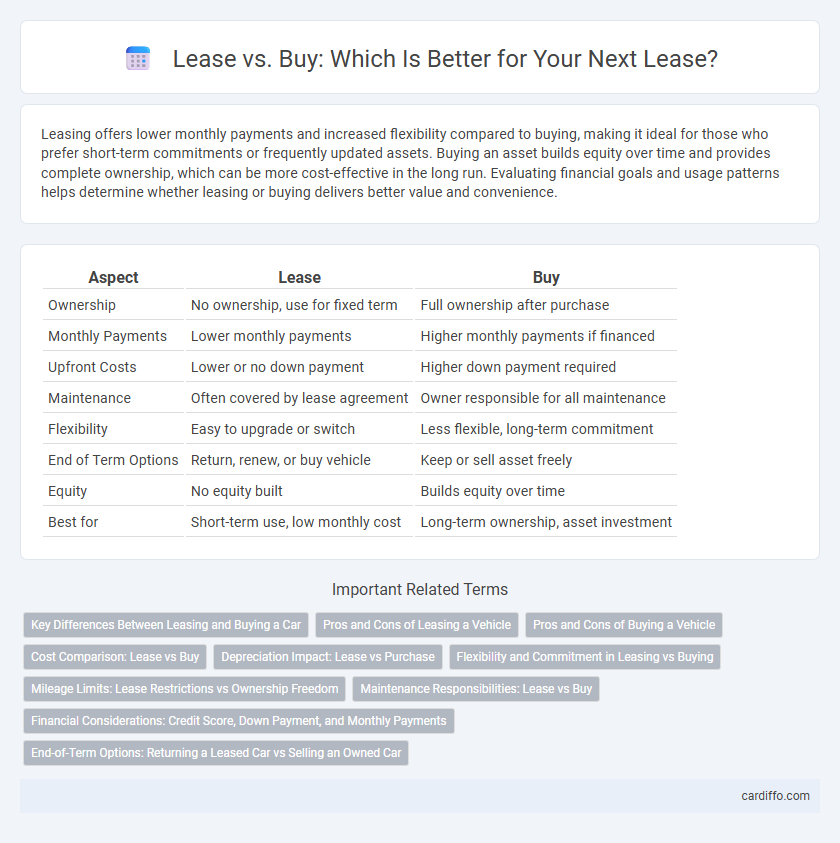Leasing offers lower monthly payments and increased flexibility compared to buying, making it ideal for those who prefer short-term commitments or frequently updated assets. Buying an asset builds equity over time and provides complete ownership, which can be more cost-effective in the long run. Evaluating financial goals and usage patterns helps determine whether leasing or buying delivers better value and convenience.
Table of Comparison
| Aspect | Lease | Buy |
|---|---|---|
| Ownership | No ownership, use for fixed term | Full ownership after purchase |
| Monthly Payments | Lower monthly payments | Higher monthly payments if financed |
| Upfront Costs | Lower or no down payment | Higher down payment required |
| Maintenance | Often covered by lease agreement | Owner responsible for all maintenance |
| Flexibility | Easy to upgrade or switch | Less flexible, long-term commitment |
| End of Term Options | Return, renew, or buy vehicle | Keep or sell asset freely |
| Equity | No equity built | Builds equity over time |
| Best for | Short-term use, low monthly cost | Long-term ownership, asset investment |
Key Differences Between Leasing and Buying a Car
Leasing a car typically involves lower monthly payments and allows for driving a new vehicle every few years, while buying a car requires a larger upfront payment but results in full ownership and no mileage restrictions. Lease agreements often include mileage limits and penalties for excessive wear, whereas purchased vehicles offer unlimited use and the option to sell or modify the car. Understanding depreciation, total cost of ownership, and long-term financial impacts is essential when choosing between leasing and buying a car.
Pros and Cons of Leasing a Vehicle
Leasing a vehicle offers lower monthly payments and access to newer models with advanced technology, reducing upfront costs and depreciation concerns. However, leases impose mileage limits and potential excess wear fees, restricting customization and long-term ownership benefits. Opting for leasing suits drivers seeking short-term flexibility while buyers benefit from ownership equity and unlimited use.
Pros and Cons of Buying a Vehicle
Buying a vehicle offers full ownership, allowing unlimited customization and no mileage restrictions, which benefits long-term users who prefer equity in their asset. However, buyers face higher monthly payments, depreciation costs, and potential maintenance expenses compared to leasing. Ownership suits those who drive extensively or plan to keep the vehicle for many years to maximize return on investment.
Cost Comparison: Lease vs Buy
Leasing typically requires lower monthly payments compared to buying, as it covers only the vehicle's depreciation during the lease term rather than the full purchase price. Buying a vehicle involves higher upfront costs and monthly payments but builds equity and offers potential long-term savings if the car is kept beyond loan repayment. Over a standard three-year period, leasing may be more cost-effective for those seeking new vehicles regularly, while buying proves economical for long-term ownership and resale value recovery.
Depreciation Impact: Lease vs Purchase
Leasing a vehicle minimizes the impact of depreciation since lease payments are based on the asset's residual value rather than its initial cost, reducing financial exposure to value loss. In contrast, purchasing a vehicle results in direct depreciation of the asset on the balance sheet, impacting equity and potential resale value over time. Buyers bear the full depreciation risk, whereas lessees transfer most of this risk to the lessor, optimizing cash flow and asset management strategies.
Flexibility and Commitment in Leasing vs Buying
Leasing offers greater flexibility by allowing businesses or individuals to upgrade or change assets more frequently without long-term commitments, making it ideal for rapidly evolving needs. Buying usually requires a higher upfront investment and locks the owner into a fixed asset, limiting adaptability over time. Lease agreements typically have shorter terms and fewer financial risks, whereas purchasing involves ownership responsibilities and potential depreciation costs.
Mileage Limits: Lease Restrictions vs Ownership Freedom
Leases impose strict mileage limits, often between 10,000 to 15,000 miles per year, with costly penalties for exceeding them, restricting driving freedom. Ownership offers unlimited mileage, allowing vehicle use without constraints or extra fees tied to distance driven. Understanding mileage limitations is crucial when deciding between leasing a vehicle and outright ownership.
Maintenance Responsibilities: Lease vs Buy
Lease agreements typically place maintenance responsibilities on the lessor, reducing the lessee's out-of-pocket expenses for repairs and upkeep. Buying a vehicle or equipment often transfers full maintenance duties to the owner, potentially increasing long-term costs but allowing more control over service quality. Understanding the differences in maintenance obligations is crucial for businesses and individuals weighing lease versus purchase decisions.
Financial Considerations: Credit Score, Down Payment, and Monthly Payments
Leasing typically requires a lower down payment and results in lower monthly payments compared to buying, making it more accessible for individuals with moderate credit scores. Buying a vehicle often demands a higher upfront down payment and can positively impact credit score over time through consistent, full loan repayments. Evaluating the impact on credit score, initial cash outlay, and monthly financial commitment is crucial when deciding between leasing and buying.
End-of-Term Options: Returning a Leased Car vs Selling an Owned Car
End-of-term options for leased cars typically include returning the vehicle to the dealership or purchasing it at a predetermined price, offering predictable costs and flexibility. Selling an owned car involves handling private sales or trade-ins, which can result in variable returns influenced by market demand and vehicle condition. Lease returns eliminate the hassle of selling but may include fees for excess wear or mileage, while owners have potential equity that could lead to financial gain upon sale.
Lease vs Buy Infographic

 cardiffo.com
cardiffo.com